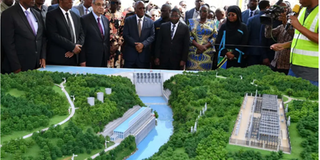Nyerere hydro-power dam to take 66 per cent of energy budget

What you need to know:
- The amount allocated for the construction of the dam commonly referred to as ‘Stiegler’s gorge’ is also equivalent to 66.4 per cent of the ministry’s development budget, according to the ministry’s budget plan presented to Parliament yesterday
Dar es Salaam. The 2115MW Julius Nyerere Hydropower Project will gobble 65.54 per cent of the total budget for the ministry of energy in the 2020/21 fiscal year, according to the docket minister, Dr Medard Kalemani.
The amount allocated for the construction of the dam commonly referred to as ‘Stiegler’s gorge’ is also equivalent to 66.4 per cent of the ministry’s development budget, according to the ministry’s budget plan presented to Parliament yesterday.
It will be the second consecutive financial year for the dam project to be the main key expenditure focus for the ministry, with the government raising its allocation by nearly 10 per cent this year.
In the 2019/2020 fiscal plan, the ministry set aside Sh1.22 trillion or 56.9 per cent of the total budget for the initial plans to construct the dam.
The ministry’s budget was Sh2.142 trillion that year.
Yesterday, Dr Kaleman said the whole allocation to the project had been disbursed by April 2020.
President John Magufuli has made the dam one of his signature infrastructure projects even though it had not been originally listed under the country’s Five Year Development Plan II.
The head of State considers the project a legacy to honour Mwalimu Julius Nyerere, the founding president of Tanzania and assure energy self sufficiency.
The construction of the dam project has been in the card for decades but received opposition, especially in the international circles over environmental concerns as well as the reported high cost of establishment when compared to green energy alternatives.
In Parliament Dr Kalemani requested for approval of Sh2.197 trillion, a 2.5 per cent rise over last year’s budget.Sh2.168 trillion of the total budget has been set aside for development projects, meaning after the dam, the remainder of Sh728 billion will be shared among other projects.
“Activities that will be implemented by the dam project during this financial year include building the main dam and spill-ways, construction of tunnels, erection of an area for installation of a power house and as well as structuring a place for the switch center,” the minister told the parliament.
He said this year’s allocation for the project was Sh221 billion more. According to the minister, the project on Rufiji Basin in Coast Region has employed 3,897 people.
Tax payers will shoulder Sh1.968 trillion of the dam’s bill for the year while Sh200.75 billion will be externally sourced.
The ministry will spend Sh28.4 billion for recurrent expenditure, including Sh13.374 billion for payment of salaries and Sh15.03 billion for other Charges (OC).
He named other power generation projects that will be implemented this fiscal year and respective allocations as Ruhudji power project (Sh255.58bn/558MW), extension of the 185MW Kinyerezi I project (Sh138bn) and the 222MW Ramakali project (Sh23bn).
Other projects are the 87MW Kakono project (Sh1.56bn), 300MW Kikonge project (1.04BN), 300MW project in Mtwara (Sh500M), 45MW Malagarasi project (Sh100m), the 80MW Rusumo (Sh13.8m) and several solar and coal power generation projects.
According to Dr Kalemani, other project would involve implementation of 400kV pow-er transmission projects from Singida, Arusha to Namanga (Sh30.2bn) and 220kV from Geita to Nyakanazi (Sh25.3bn).
The implementation of the second phase project to con-struct 400 kV power transmission line from Nyakanazi to Kigoma (Sh34.3bn), the 400 kV project from the Julius Nyerere Center –Chalinze-Dodoma (Sh8.4bn), the kV 400 line from Chalinze to Kinyerezi (Sh3.89bn).
“During the said financial year, Sh5bn has been allocated for the project to connect Kigo-ma Region to the national grid through Tabora Region.
Also, the 400 kV transmission line from Iringa-Mbeya-Tunduma to Sumbawanga will be constructed,” he said.
Dr Kalemani said the country’s power generation capacity has reached 1,601.84MW out of which 1,565.72 is injected directly to the national grid.
According to him, 573.7MW is generated from water, 892.72 is produced from natural gas, 88.80 from crude oil, 10.50MW from biomass.
He said the Tanzania Electric Supply Company (Tanesco) generate 36.12MW which is, however, not connected in the national grid.
The Energy and Minerals Committee chairman, Mr Dunstan Kitandula, called on for the government to ensure funds for implementation of the JNHPP is disbursed on time.
“Supervision for implementation of the project should also be increased because the project has reached an important stage of implementation,” he said.
Also, he called on the government to ensure the country had enough fuel reserve following unpredictability of the global fuel business and possibility of serious economic recession that will be caused of the Covid-19 pandemic.
According to him, the government should also reflect on the best way of implementing the Rural Energy (REA) projects that depend on fuel levy as among important sources of funds.


